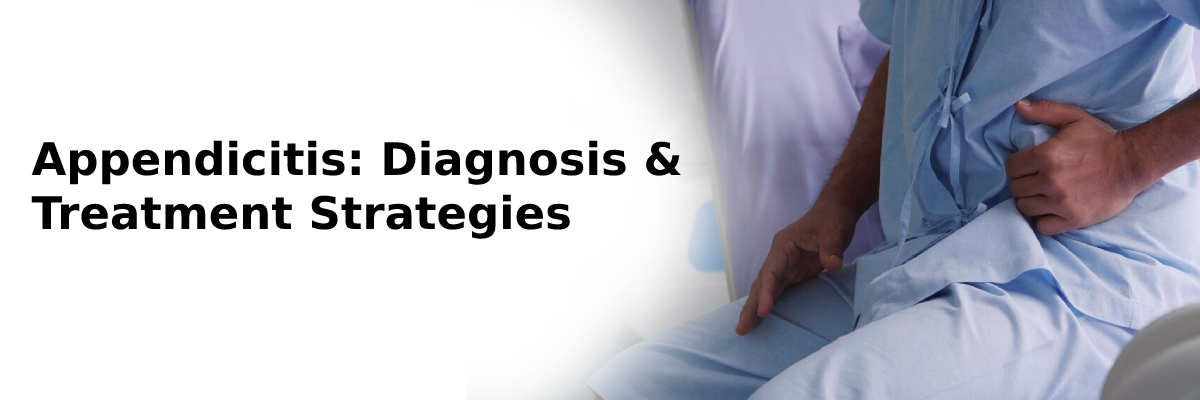
 IJCP Editorial Team
IJCP Editorial Team
Appendicitis: Diagnosis & Treatment Strategies
The appendix is a small, finger-shaped pouch hanging off the large intestine located on the abdomen's lower right side. Appendicitis occurs when your appendix gets inflamed and filled with pus. It is a medical emergency requiring prompt treatment. An infected appendix can rupture and cause potentially life-threatening complications if left untreated. The common symptoms of appendicitis are:
Pain in the lower right abdomen that may start as a dull ache but then becomes sharper as the inflammation worsens. This pain is usually the first and most common symptom of appendicitis. It may begin around the navel and then move to the lower right aspect of the abdomen. As the inflammation becomes worse, the pain becomes more severe and intense. The increased pain and inflammation may induce:
Loss of appetite
Nausea and vomiting
Constipation or diarrhea
Abdominal swelling
Area around the appendix may feel hard to the touch.
A fever of 100.4°F (38°C) or higher is another common symptom of appendicitis. The patient's temperature may rise as the body fights off the infection.
Though these signs characterize appendicitis, the appearance of symptoms and their severity may vary from individual to individual. Additionally, these conditions may also symptomize other manifestations, so it is vital to see a doctor for a proper diagnosis.
Causes of Appendicitis
The exact cause of appendicitis isn't known, but it is believed to be caused by blockages in the appendix. These blockages can occur due to:
Fecal impaction: A buildup of hardened stool in the appendix can cause a blockage, leading to inflammation and infection.
Enlarged lymphoid follicles: The lymphoid follicles in the appendix can enlarge and cause a blockage, leading to inflammation and infection.
Worm infestation: Certain worms can infest the appendix and cause a blockage, leading to inflammation and infection.
Trauma: Trauma to the abdomen, such as a blow or injury, can cause the appendix to become inflamed.
Diagnosis and Treatment of Appendicitis
If you suspect you have appendicitis, it is essential to see a doctor as soon as possible. The following tests may be used to diagnose appendicitis:
Physical examination: The doctor will perform a physical examination, including a thorough examination of the abdomen. They may press on the lower right side of the abdomen to see if it is tender to the touch.
Pathological evaluation: Tests such as blood tests and urine tests can help evaluate the infection and its degree of severity.
CT scan: A CT scan is an imaging test that uses X-rays to produce detailed images of the inside of the body. Doctors can use it to diagnose appendicitis by showing any inflammation or infection in the appendix.
Ultrasound: An ultrasound is a non-invasive test that uses sound waves to help visualize the inside of the body. It can help diagnose appendicitis by showing any inflammation or infection in the appendix, albeit with much less accuracy than a CT scan.
The standard treatment for appendicitis is appendectomy which involves surgical removal of the appendix. The surgery can be an open surgery or a laparoscopic procedure. During open surgery, a single large incision is made in the abdomen, and the appendix is removed through this incision. During laparoscopic surgery, several small incisions are made in the abdomen, and a laparoscope (a tiny camera) is inserted through one of the incisions. The surgeon views the inside of the abdomen on a monitor and uses instruments inserted through the other incisions to remove the appendix. After the surgery, the patient will be closely monitored for complications such as infection, bleeding, or leakage from the surgical site. In open surgery, the recovery period is longer, and the patient requires staying in the hospital for several days. However, laparoscopic surgery requires a shorter hospital stay and a quicker recovery.
Clinical Complications Associated with Appendicitis
Ruptured appendix: If left untreated, an infected appendix can rupture and cause potential life-threatening complications. Symptoms of a ruptured appendix include severe abdominal pain, fever, and vomiting.
Peritonitis: If the appendix ruptures, bacteria and pus can spill into the abdomen, causing an infection called peritonitis. It is a severe condition that requires immediate treatment.
Abscess: If the appendix ruptures, an abscess (a pocket of pus) may form near the site. This abscess may need to be drained with a needle or through surgery.
Prevention of Appendicitis
It is not possible to prevent appendicitis, but you can reduce your risk by:
Eating a high-fiber diet to prevent constipation: Fiber is essential for maintaining regular bowel movements and can help prevent constipation, which is one of the leading causes of appendicitis.
Drinking plenty of water to keep your stools soft: Drinking enough water is essential for preventing constipation and keeping your stools soft.
Avoid foods that cause gas and bloating: Certain foods, such as beans, onions, and broccoli, can cause gas and bloating. Avoiding these foods may help prevent appendicitis.
Getting regular exercise: Regular exercise can help prevent constipation and maintain regular bowel movements.

IJCP Editorial Team
Comprising seasoned professionals and experts from the medical field, the IJCP editorial team is dedicated to delivering timely and accurate content and thriving to provide attention-grabbing information for the readers. What sets them apart are their diverse expertise, spanning academia, research, and clinical practice, and their dedication to upholding the highest standards of quality and integrity. With a wealth of experience and a commitment to excellence, the IJCP editorial team strives to provide valuable perspectives, the latest trends, and in-depth analyses across various medical domains, all in a way that keeps you interested and engaged.









.png)




Please login to comment on this article